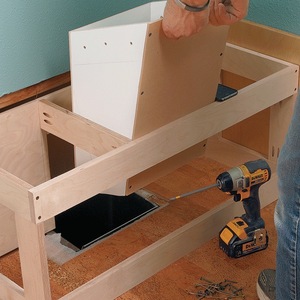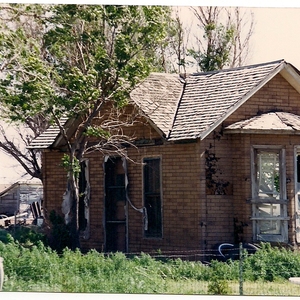I had to go into my crawl space (about 350sq ft) to splice a cable wire. I noticed that a portion of the flooring was damp. Space has a poly liner with 4″ of pea stone. Underside of floor has insulation and the walls are tarred. Over the damp area near an open vent, water droplets were covering the insulation and droplets were on the exposed joists.
Again, only a portion of the floor was damp. I am suspecting condensation that is being “feed” from the vent that is allowing warm, moist air to enter the space.
My question is should c spaces be ventilated? or is it better to keep it sealed during all seasons?


















Replies
You are correct...closed up is usually a good move...even better is to insulate the crawl and condition the space too.
Thanks for your input on venting my crawl space. One question, what do you mean by "conditioning the space".
One question, what do you mean by "conditioning the space".
Conditioning the space means treating it like the rest of the house: heating it in the winter and air conditioning it in the summer (if applicable). Conditioning the space can be very expensive unless you prepare the crawlspace first. Right now it sounds like your conditioning envelope does not include the crawlspace (your insulation is under the floor, not on the walls/ground of the crawl).
You are running into a hotly debated item: vent a crawl or seal it.
The "vent it" folks say that the air circulating down there will help dry it out and keep toxic mold/radon/et al from building up.
The "seal it" folks say the ventilation doesn't really work because in humid areas you are actually introducing hot-moist air into a cool crawlspace, which induces condensation and during the winter, those vents won't seal well enough to keep cold air out. So they suggest using various poly products to seal the crawlspace and then bringing it within the conditioned envelope. Basically treating it like a short basement (without the concrete).
The "vent it" folks fire back and point out that it is very difficult to seal a crawlspace and that you would just be making a mold colony if you didn't do it correctly.
The debate is ongoing. On my current house, I'm am heading towards a sealed crawl space, but I am not an expert on one way or the other. There was a FHB article about sealing a crawl a while back. Good article.jt8
"A tree is known by its fruit; a man by his deeds. A good deed is never lost; he who sows courtesy reaps friendship, and he who plants kindness gathers love." -- Saint Basil
When I bought my house the crawl space was vented year round. The floors were cold in the winter and the space was very humid in the summer. I spent a lot of time sealing it up. Spray foam in cracks and around the vents. Sealing pipe and wire openings. I run a dehumidifier year round,. I feel the house is better insulated. The floors are warmer in the winter and the space is very dry.
Good info, thanks!
Buildingscience.com has a lot of info about moisture control.Here's a PDF file from them about crawlspaces and venting:http://www.buildingscience.com/resources/foundations/conditioned_crawl.pdf
To all you virgins - Thanks for nothing.
Crawlspaces are vented mainly because it was written into early building codes in 1947, believe it or not, as a means to reduce moisture in attics. Damp attics nearly always connect to damp foundations. Back then, building science was in its infancy, and we didn't have the effective materials, such as poly, that we do today. Even though most building scientists today will tell you that venting crawlspaces almost never dries them, as Reagan said, "The closest thing to eternal life we have on this planet is a government program." So, written in 1947, ineffective immediately, and still going strong 60 years later.
Andy
"Never try to teach a pig to sing. It wastes your time and annoys the pig." Robert A. Heinlein
"Get off your dead #### and on your dying feet." Mom
Damp attics nearly always connect to damp foundations.
Andy:
I have heard/read this statement twice in the past 2 weeks. I believe it is a quote from an early researcher (I don't remember his name) as the other person quoting above mentioned it. I believe that this is not the case presently.
Most attic moisture problems now are from generally tighter homes with no air exchangers/HRV's/ERV's but with still a fair amount of hidden air leakage at the ceiling level. Jim White, retired Senior Researcher at CMHC, mentioned what was happening in even older homes when the walls got resided with newer sealed joint building wraps/sheathing membranes as well as new tighter windows:
Since no airsealing is done on the house with this siding job, attic and sill air leakage remains at the same levels. Since we tightened the walls to almost airtight, the stack or chimney effect on the house got stronger, drawing more moist house air into the attic. He said that we're now starting to "live in chimneys". Let alone that more moisture will get into the attic, the stronger chimney effect makes the ambient slight negative pressure found in basements go more negative, increasing the chance of backdrafting from naturally aspirating chimneys and equipment.
I suspect we're both right. The situation you describe makes perfect sense, but I wonder if it's more common up north than down here? The level of air sealing in the houses I see is abysmal. And my own experience backs up my original statement about attics and foundations. The two are of course linked by the stack effect.
To get the levels of attic moisture I've seen in some houses without factoring in foundations, the owners would have to be rendering maple syrup in the kitchen.Andy
"Never try to teach a pig to sing. It wastes your time and annoys the pig." Robert A. Heinlein
"Get off your dead #### and on your dying feet." Mom
Are there a lot of crawl space/partial foundations with dirt floors in your area?
Yes, and those are the biggest offenders. I was in one last week where they run a dehumidifier year round.Andy
"Never try to teach a pig to sing. It wastes your time and annoys the pig." Robert A. Heinlein
"Get off your dead #### and on your dying feet." Mom
>> >>Damp attics nearly always connect to damp foundations.
>>I have heard/read this statement twice in the past 2 weeks. I believe it is a quote from an early researcher (I don't remember his name) as the other person quoting above mentioned it. I believe that this is not the case presently.
I'm with Andy, but note: he's looking at the whole housing stock, you're apparently looking at current construction. ('presently")
In my area, it is very rare to have moisture problems in the attics of newer construction (say, 80's on)
And it's rare to see attic moisture problems (mildew mold over a wide area - e.g., not just above a bath or kitchen) where the basement or crawlspace is dry.
I usually inspect the attic before the crawl - the condition of the attic gives me a pretty reliable indication of what the conditions in the crawl will be.
Bob, that's a good point about new construction. The air sealing is still lousy, but at least they've got a vb under the slab and a waterproofed foundation.Andy
"Never try to teach a pig to sing. It wastes your time and annoys the pig." Robert A. Heinlein
"Get off your dead #### and on your dying feet." Mom
IMO and experience (and in my area/climate - NW OH), go for a conditioned crawlspace only if you have central forced air conditioning (which you use) and heat.
A "sealed" conditioned crawlspace in my experience is not a good idea if you aren't pumping some dry air down there in the summer.
As to the "you have to seal it well for a conditioned space to work:" Not in my experience.
I see a fair number of crawls which are "accidentally" conditioned (e.g., by a disconnected duct) and they generally function like conditioned spaces, even without all the detailing some call for in "officially" conditioned crawls.
Note: different climates may have different results.